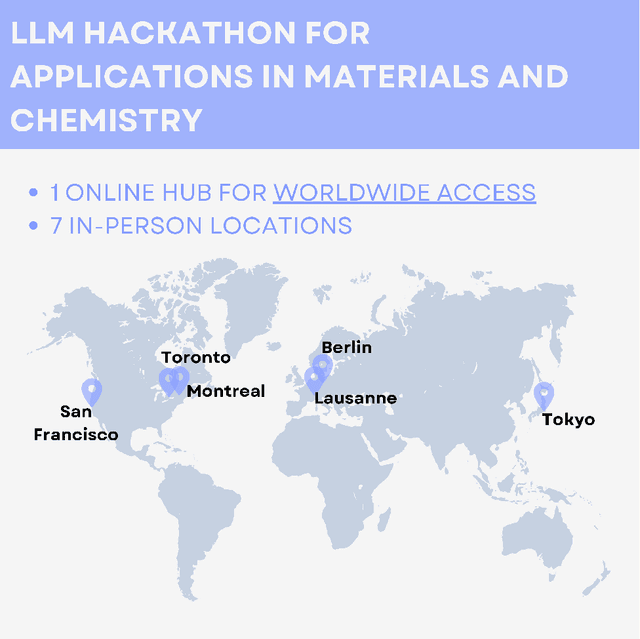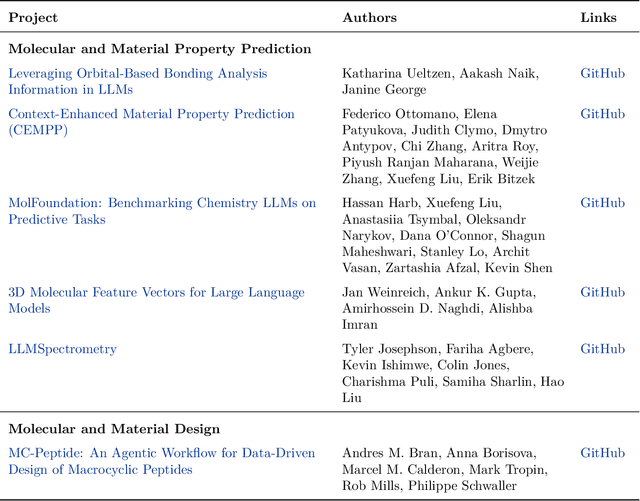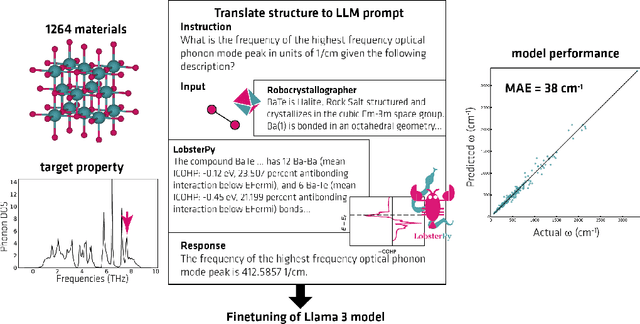Sebastian Pagel
Reflections from the 2024 Large Language Model (LLM) Hackathon for Applications in Materials Science and Chemistry
Nov 20, 2024



Abstract:Here, we present the outcomes from the second Large Language Model (LLM) Hackathon for Applications in Materials Science and Chemistry, which engaged participants across global hybrid locations, resulting in 34 team submissions. The submissions spanned seven key application areas and demonstrated the diverse utility of LLMs for applications in (1) molecular and material property prediction; (2) molecular and material design; (3) automation and novel interfaces; (4) scientific communication and education; (5) research data management and automation; (6) hypothesis generation and evaluation; and (7) knowledge extraction and reasoning from scientific literature. Each team submission is presented in a summary table with links to the code and as brief papers in the appendix. Beyond team results, we discuss the hackathon event and its hybrid format, which included physical hubs in Toronto, Montreal, San Francisco, Berlin, Lausanne, and Tokyo, alongside a global online hub to enable local and virtual collaboration. Overall, the event highlighted significant improvements in LLM capabilities since the previous year's hackathon, suggesting continued expansion of LLMs for applications in materials science and chemistry research. These outcomes demonstrate the dual utility of LLMs as both multipurpose models for diverse machine learning tasks and platforms for rapid prototyping custom applications in scientific research.
Validation of the Scientific Literature via Chemputation Augmented by Large Language Models
Oct 08, 2024Abstract:Chemputation is the process of programming chemical robots to do experiments using a universal symbolic language, but the literature can be error prone and hard to read due to ambiguities. Large Language Models (LLMs) have demonstrated remarkable capabilities in various domains, including natural language processing, robotic control, and more recently, chemistry. Despite significant advancements in standardizing the reporting and collection of synthetic chemistry data, the automatic reproduction of reported syntheses remains a labour-intensive task. In this work, we introduce an LLM-based chemical research agent workflow designed for the automatic validation of synthetic literature procedures. Our workflow can autonomously extract synthetic procedures and analytical data from extensive documents, translate these procedures into universal XDL code, simulate the execution of the procedure in a hardware-specific setup, and ultimately execute the procedure on an XDL-controlled robotic system for synthetic chemistry. This demonstrates the potential of LLM-based workflows for autonomous chemical synthesis with Chemputers. Due to the abstraction of XDL this approach is safe, secure, and scalable since hallucinations will not be chemputable and the XDL can be both verified and encrypted. Unlike previous efforts, which either addressed only a limited portion of the workflow, relied on inflexible hard-coded rules, or lacked validation in physical systems, our approach provides four realistic examples of syntheses directly executed from synthetic literature. We anticipate that our workflow will significantly enhance automation in robotically driven synthetic chemistry research, streamline data extraction, improve the reproducibility, scalability, and safety of synthetic and experimental chemistry.
 Add to Chrome
Add to Chrome Add to Firefox
Add to Firefox Add to Edge
Add to Edge